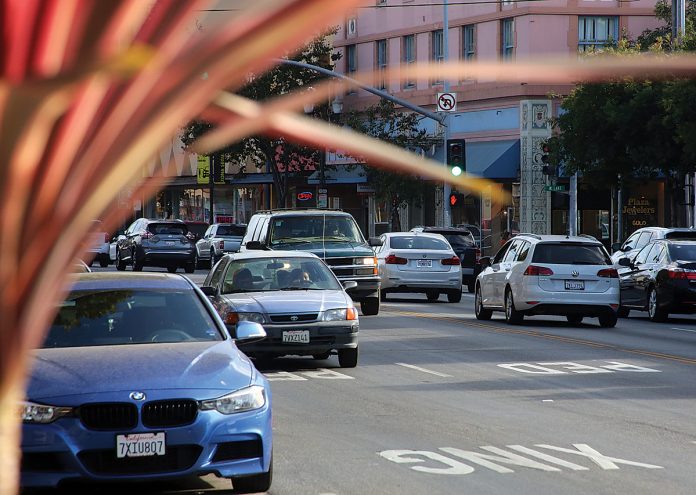WATSONVILLE—The Watsonville City Council on Tuesday unanimously approved the Downtown Complete Streets Plan, a $27 million project that proposes sweeping changes to the corridor’s structure.
The plan presented at Tuesday’s meeting included the much-debated lane reduction on Main Street, which the public was strongly opposed to in Phase 3 of community outreach, according to city staff.
The lane reduction cannot happen until the City identifies its effects through a traffic study, set to be completed in 2021 alongside the City’s Downtown Specific Plan, which is currently being developed in consideration of the Complete Streets Plan.
All council members said the implementation of the lane reduction hinges on that traffic study.
Additionally, no changes to Main Street can happen without the approval from CalTrans because the street serves as a highway thoroughfare.
“We need to seriously think about this. When we’re hearing a ‘no,’ it means no,” said Councilwoman Trina Coffman-Gomez. “It doesn’t mean revisit and going back again and again and rehashing things because it’s what the staff wants done versus what the community is saying.”
Other improvements to adjacent downtown streets can move forward following Tuesday’s decision. A phased plan of attack will be prepared by staff for Council approval in the coming months.
Any change to the downtown streets would need final approval from the Council.
The proposed improvements include:
Pedestrian improvements
• Curb extensions at almost every intersection
• High-visibility crosswalks
• Widened sidewalks in several areas
Bicycle facilities
• Buffered bicycle lanes on Main Street
• Shared-lane marking on Brennan and Union streets
• Bike lane improvements on Rodriguez Street
• Bicycle lanes on Lake and Beach streets
Vehicle travel lane changes
• Removal of one lane each direction on Main Street to allow for bicycle lanes and some added parking
• Removal of one lane on Rodriguez Street between W. Lake and W. Beach streets
Parking changes proposed
• Addition of on-street parking on Main Street in several areas
• Removal of parking on the north side of W. Lake Street between Main and Rodriguez streets
• Removal of parking on Maple Street between Main and Union streets.
“This plan is more than just looking at a road diet,” said Public Works & Utilities Assistant Director Maria Esther Rodriguez.
The total cost for preparation of the plan is $227,000. A pair of grants will cover $191,000 of the cost and the remaining $36,000 will be paid with Measure D funds.
The implementation of the plan costs roughly $27 million. The improvements on Main Street would be the most expensive item at $7.08 million. Much of that cost will be covered by grants, city staff said.
A draft of the plan was presented to the Council in May. It received heavy criticism from the public, but the Council approved its development, citing the city’s ongoing fight to make its roads safer.
Watsonville was ranked near the bottom of the state in pedestrian safety for cities its size in a recent report by the Community Traffic Safety Coalition. That spurred the City’s current push for traffic safety, including the adoption of Vision Zero, a multi-national initiative that acknowledges traffic fatalities are preventable and aims to come up with solutions to achieve a zero death goal by 2030.
Aspects of Vision Zero are already underway, but Council said the education and enforcement in that plan can only do so much to slow down traffic on Main Street.
“Status quo right now is unacceptable…these are all preventable things,” Mayor Francisco Estrada said. “It indicates that we have to do something for our youth, for our older folks and everyone in this community and for their health.”
The public in attendance at Tuesday’s meeting was in support of the plan.
Foreverfly Skate owner Salvador Orozco said he sees a “near-miss” at the crosswalk of his shop at 442 Main St. every day.
“Cars are flying by—45 mph at least,” Orozco said.
Orozco also said the changes to Main Street, such as making the sidewalks bigger, would be a boon for the businesses in the corridor.
“More foot traffic, for me as a business, will turn into sales,” Orozco said. “I want Watsonville to be a destination.”
Councilman Aurelio Gonzalez said some residents might be “fearful” of the lane reduction, but the possible economic positives of that proposal could revitalize the sleepy corridor.
“We have an exodus of our communities that are leaving our town and shopping outside of our town. We have a lot of our youth that are leaving our town and shopping out of our town,” Gonzalez said. “What we want to do is bring atmosphere that’s safe for the people to walk up and down Main Street.”
Gonzalez said that interest in downtown spaces has picked up with the recent changes and the plans currently in development.
“We have a lot of people knocking on the door that want to do business downtown,” Gonzalez said. “They like the change that’s happening.”













